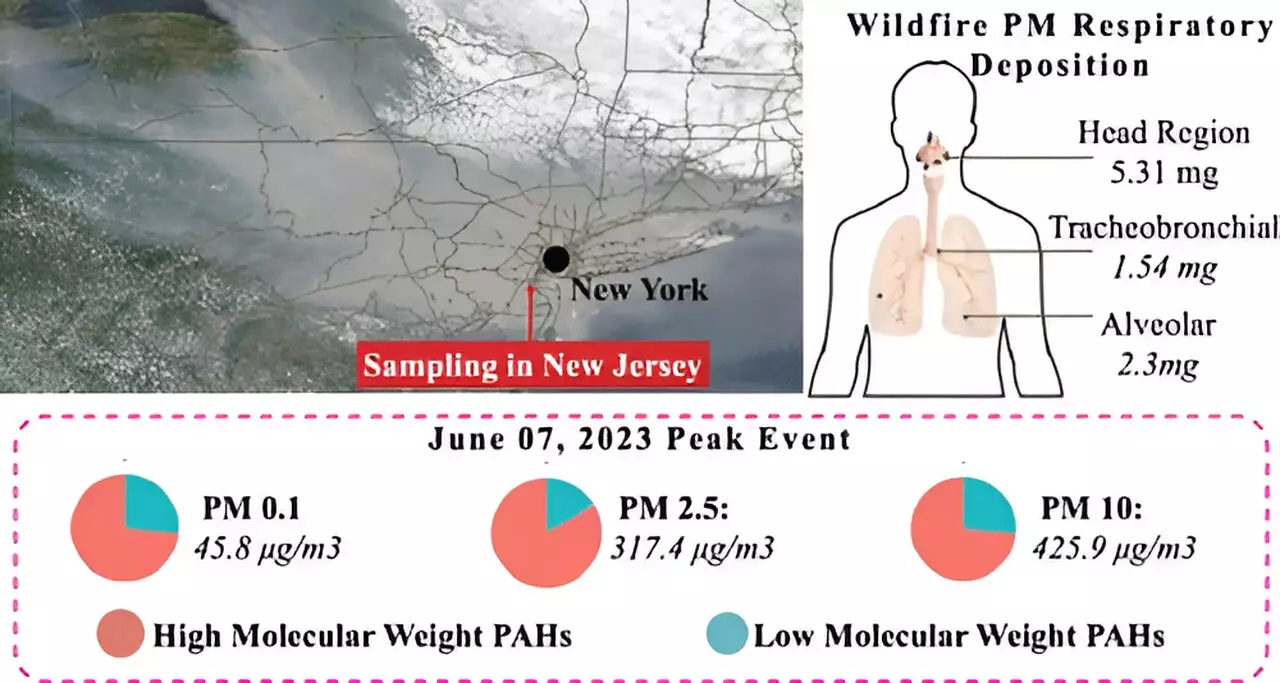The recent wildfire events fueled by climate change have raised alarms regarding their pervasive effects on air quality across various regions, particularly in the Northeast United States. A study conducted by researchers from Rutgers University has brought to light the significant health risks associated with wildfire-generated particulate matter, accentuating a potential public health crisis. This article delves into the findings of the study published in *Environmental Science & Technology* while exploring its implications on air quality and human health.
Particulate matter (PM) is a term that refers to tiny particles suspended in the air, which can penetrate lungs and enter the bloodstream, posing severe health risks. According to lead researcher, Jose Guillermo “Memo” Cedeño Laurent, the rising frequency of climate-driven wildfires has emerged as a critical contributor to the deteriorating quality of air in urban environments, particularly affecting over 100 million residents in the Northeast. The research established that these wildfires release harmful particulate matter that significantly surpasses national air quality standards, marking a troubling setback in the progress made over the past few decades.
In June 2023, a significant wildfire incident sent shockwaves through New Jersey and New York City, leading to urgent advisories as air quality plummeted. The Rutgers study meticulously evaluated the composition of particulate matter gathered during this event, identifying high levels of polycyclic aromatic hydrocarbons (PAHs), compounds that are recognized for their carcinogenic properties. At the peak of this wildfire, the concentration of ultrafine and fine particulate matter was documented to be almost tenfold higher than acceptable air quality standards, showcasing a stark warning regarding the health impacts linked with such pollution.
Research has increasingly underscored the association between wildfire pollution and adverse health outcomes. Cedeño Laurent pointed out that emerging epidemiological studies have already started correlating the recent wildfire events to heightened rates of respiratory and cardiovascular issues in urban healthcare settings, particularly in New York City. Although comprehensive understanding of the mechanisms behind these effects is still developing, the findings underline an urgent call to action for public health professionals to investigate and devise strategies to combat the challenges posed by wildfire smoke.
The implications of the Rutgers study are underscored by its quantification of inhalation doses of particulate matter. Over a mere 72-hour exposure period following the wildfire, they estimated that approximately 9 micrograms of particulate matter infiltrated the lungs of exposed individuals. This data not only highlights the severity of the pollution but also emphasizes the critical need to deepen the investigation into the toxicological effects of these particles, particularly given their reported association with numerous organ-specific health impacts.
The study has prompted further collaborations among various institutions, including prominent health and research centers. These collaborations aim to evaluate the extensive range of health consequences stemming from wildfire smoke, examining their impact on different organs such as the lungs, heart, brain, and reproductive system. This multidisciplinary approach signifies the urgent need to comprehend the health implications of these environmental hazards in detail, thereby aiding preventive and remedial public health measures.
As the academic community moves forward, the focus must shift towards elucidating the physical and chemical transformations that wildfire-generated air pollution undergoes compared to traditional sources of air pollution. Cedeño Laurent and senior author Philip Demokritou stress that their findings have the potential to empower public health assessors, enabling them to evaluate risks more effectively and coordinate relevant strategies for communities grappling with chronic air quality challenges.
In addition, the research network plans to explore the optical properties of wildfire smoke in a companion study. This analysis carries immense significance as it connects the particulate matter’s composition to broader climatic changes, suggesting a feedback loop that exacerbates air quality issues in urban settings.
The Rutgers research serves as a pivotal reminder of the far-reaching consequences of climate-driven wildfires, not only on air quality but also on public health. As the frequency and intensity of these events increase, it is crucial for both researchers and policymakers to continue investigating the complex interplay of wildfire smoke and human health, ensuring that preventive strategies are not only developed but also implemented effectively to safeguard vulnerable communities. By understanding and mitigating the risks associated with particulate matter, we can create more resilient urban environments in the face of climate adversity.

